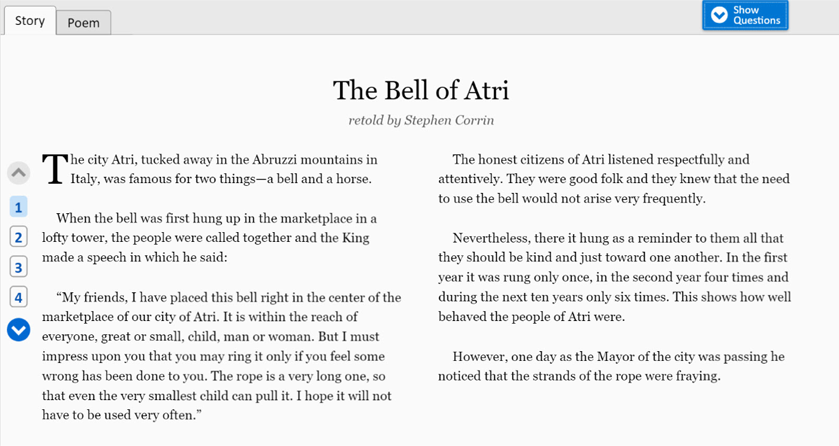Sample Questions
The NAEP reading assessment measures students’ reading comprehension of literary and informational texts. Students read grade appropriate texts and answer questions about them that require both literal and interpretive understanding as well as critical thinking skills. The NAEP reading framework guides the content and development of the reading assessment at grades 4, 8, and 12.
The 2022 digitally based reading assessment at grades 4 and 8 used discrete question sets as well as scenario-based tasks, which consist of sequences of connected questions and concepts integrated into a single real-world scenario. The assessment comprised selected-response and constructed-response questions. All reading assessment questions are classified by one of three NAEP reading cognitive targets.
The following texts and questions released from the NAEP reading assessment provide an example of the literary subscale at grade 4 and an example of the informational subscale at grade 8.
Subscales and Percent Correct
Student performance on the NAEP reading assessment at grade 4
The decrease compared to 2019 in the national average reading score at grade 4 was reflected in both the literary and informational subscales. The decline was also reflected in the overall percent correct for the assessment questions and in the percent correct for each of the three reading cognitive targets by which each question is classified.
- At the state level, the 2022 score for the literary subscale declined in 18 states/jurisdictions and the score for the informational subscale declined in 32 states/jurisdictions compared to 2019.
- At the district level, the 2022 score for the literary subscale declined in 3 districts and the score for the informational subscale declined in 8 districts.
- The percent correct for each of the three reading cognitive targets declined in the Northeast and the Midwest regions; and in the South and the West regions, only the percent correct for critique/evaluate declined.
Bell of Atri/Birdfoot’s Grampa
Bell of Atri and Birdfoot’s Grampa are the titles respectively, of a story and a short poem presented together to students as part of the reading assessment at grade 4. Directions that introduced this set/block told students they would have 30 minutes to read a story and a poem, and to answer questions about them. No purpose was stated other than reading and responding. The first four questions in this set focus students’ attention on the story, asking about the main action and the motivation of the main characters. Then two questions focus students’ attention on the poem, asking about an image and about the difference between the two characters represented in the poem. Having answered questions about each text individually, students are then asked to make a connection between the texts, demonstrating understanding of a theme the story and poem have in common. The set continues with a question asking students to make a judgment about the most important character in the story, and with two vocabulary questions. Three of the ten questions in this set require students to provide a written answer, and the others are selected-response questions. Across the set of items, students demonstrate a variety of comprehension behaviors related to the cognitive targets—locate/recall, integrate/interpret, critique/evaluate—specified in the NAEP Reading Framework.
- Fourth-grade performance on this paired-passage literary set of ten questions ranged from 27 percent correct on a short constructed-response question to 75 percent correct on a selected-response question.
- The easiest question for fourth-graders was a selected-response, locate/recall question that required them to recognize the reason for a character’s action that had been explicitly stated in the story.
- The most difficult question for fourth-graders was a constructed-response, critique/evaluate question requiring them to form an opinion about which story character was most important and to support their opinion with information from the story.
Additional NAEP Sample Question Resources
See the NAEP Questions Tool to learn more about the released reading questions from the 2022 assessment (grades 4 and 8) and previous assessment years (grades 4, 8, and 12). The tool presents examples of students’ answers to constructed-response questions along with score commentary, the percentage of students who answered correctly and how students’ performance on a given question corresponds to their overall scores on the reading assessment.
Experience the reading digitally based assessment as students did
 Full set of reading questions
Full set of reading questionsYou can try test questions that were administered to students as part of the 2022 reading assessment. After completing the questions, you can see the correct answers, scoring rubrics, and student performance results.
Review NAEP item maps
One way to understand the NAEP reading scale is by seeing the types of questions that students performing at different points on the scale are likely to answer correctly. See the 2022 item map with a range of comprehension skills demonstrated on the reading scale and within the score range for each NAEP achievement level.





